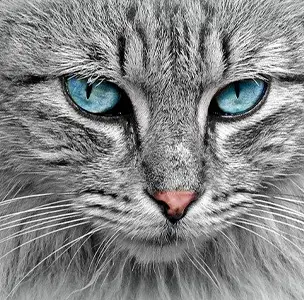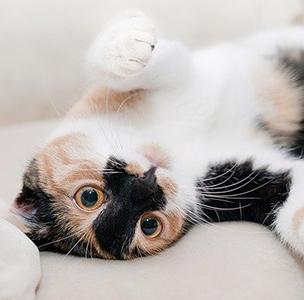Cats with diabetes are incapable of producing enough insulin in their bodies to manage blood glucose levels. When left untreated, the disease may result in severe health consequences, starting with sudden weight loss, loss of appetite, dehydration and death. Other signs of diabetes in felines are vomiting, depression, motor issues, lack of energy, and coma.

Prevalence of Feline Diabetes
There’s an estimated 2% of the feline population that has diabetes, but there’s no way of knowing the exact number due to the number of undiagnosed cases. The number of cats with the disease is increasing steadily because of the lack of care and knowledge of pet owners when it comes to proper diet and nutrition.
This is a good video that explains diabetes in cats and dogs:
Signs of Diabetes in Cats
As humans, the most obvious signs for diabetic cat behavior are those of increased urination and thirst. Those two signs are prevalent in overweight or obese cats, but it does not mean that those with average body weight don’t have diabetes. Many felines with diabetes have a voracious appetite caused by their inability to use the fuel they get from their diet.
With regard to age and weight, older and overweight cats are the most likely to develop diabetes, while there’s a valid argument that males are more affected by it than females. There also are some studies that show proof of Burmese cats being the most susceptible breed. However, don’t assume that if your cat isn’t old, overweight, or Burmese that she is safe from the disease.
Weight Loss
The inability to process glucose means that the cells in the body won’t get the essential nutrition. The body’s natural response to make up for the loss is to break down fat and muscle tissues, which results in sudden weight loss. You will know that your cat may have developed diabetes when she suddenly turns skinny.
Sudden Change in Urinating Habit
If you notice that your cat suddenly urinates outside of the litter box, then it’s indicative of a developing health issue.
Changes in Appetite
Appetite swings associated with diabetes aren’t limited to the tendency of a cat to stop eating. There are times when your furry friend suddenly eats just about everything. The reason why there are changes in appetite is that the body desperately tries to adjust to the inability of processing glucose.
Vomiting
The reason why your cat vomits is that its body is trying to get rid of the buildup of waste. When the body starts breaking down fat to produce energy, there’s no other faster way of eliminating the byproducts than vomiting.
Deteriorating Health
 There are a handful of signs of a cat’s ill health and deteriorating condition. The list includes dull eyes and dry coats. If your cat suffers heavily from infections and minor illnesses, then they’re all likely because of the disease. Another health item to keep an eye on is ketoacidosis in cats. Diabetic Ketoacidosis (DKA) is a serious and life-threatening complication of diabetes mellitus that can occur in dogs and cats. DKA is characterized by hyperglycemia, ketonemia, +/- ketonuria, and metabolic acidosis.
There are a handful of signs of a cat’s ill health and deteriorating condition. The list includes dull eyes and dry coats. If your cat suffers heavily from infections and minor illnesses, then they’re all likely because of the disease. Another health item to keep an eye on is ketoacidosis in cats. Diabetic Ketoacidosis (DKA) is a serious and life-threatening complication of diabetes mellitus that can occur in dogs and cats. DKA is characterized by hyperglycemia, ketonemia, +/- ketonuria, and metabolic acidosis.
The key to preventing long term or permanent damage from diabetes is early detection. Once you notice the first signs, you must respond by taking your furry friend to the veterinarian.
Treatment For Cats With Diabetes
Treatment centers on insulin therapy, but a healthy diet highlighted by portion control plays an integral role. Your vet may consider oral medications, but it’s not the best option because of the possible side effects. Nonetheless, you still must take your cat to the vet for blood and urine tests.
The vet will also perform a physical examination and determine behavioral signals from which insulin therapy is based. You never should administer insulin therapy without talking to the vet. Also, ask your vet about treating diabetes in cats without insulin to determine what options are available.
Blood tests are typically carried out during a visit to your vet. Some pet owners can do it on their own due to the cat diabetes cost, but if you’re unsure about how it’s done, then you’re better off getting that much-needed help from the vet. If you want to attempt to check blood glucose at home, watch this video:
Wet Versus Dry Cat Food
One of the most controversial issues about diabetes in cats is whether you feed them dry or wet food. Don’t forget that cats are by nature, carnivores. It means that they feast on protein in their natural environment, with minimal amounts of carbohydrates. It is healthier for domesticated cats to eat the type of food they get from their prey. The reason why dry food has become so popular is that it is a lot more convenient for pet owners to feed the cats with it. A diet consisting of nothing but dry food does not necessarily lead to diabetes in cats, but it is not recommended for a feline that’s already been diagnosed with the disease.
No Such Thing as a Cure
Once you realize that your cat has diabetes, you must embrace the responsibility of taking care of her and accept the fact that she’ll never be cured of it. Even with early detection, the best thing that could happen is that the condition goes into remission. Your job is to help your cat go through adversity. You control the disease so that she can live her life. Have faith that your cat will survive with good care. Knowing this will prevent you from considering things like, “should I euthanize my cat with diabetes”.
However, if you ignore cat diabetes untreated you might be facing a cat diabetes sudden death issue. Many cat owners have inquired “How long can a cat live with diabetes?” and the good news is that with proper care, exercise, and a proper diabetic cat diet, your cat can still live a long and healthy life!
The post Common Symptoms Of Cat Diabetes appeared first on Furry Friends Gear.
Common Symptoms Of Cat Diabetes posted first on https://furryfriendsgear.blogspot.com
No comments:
Post a Comment